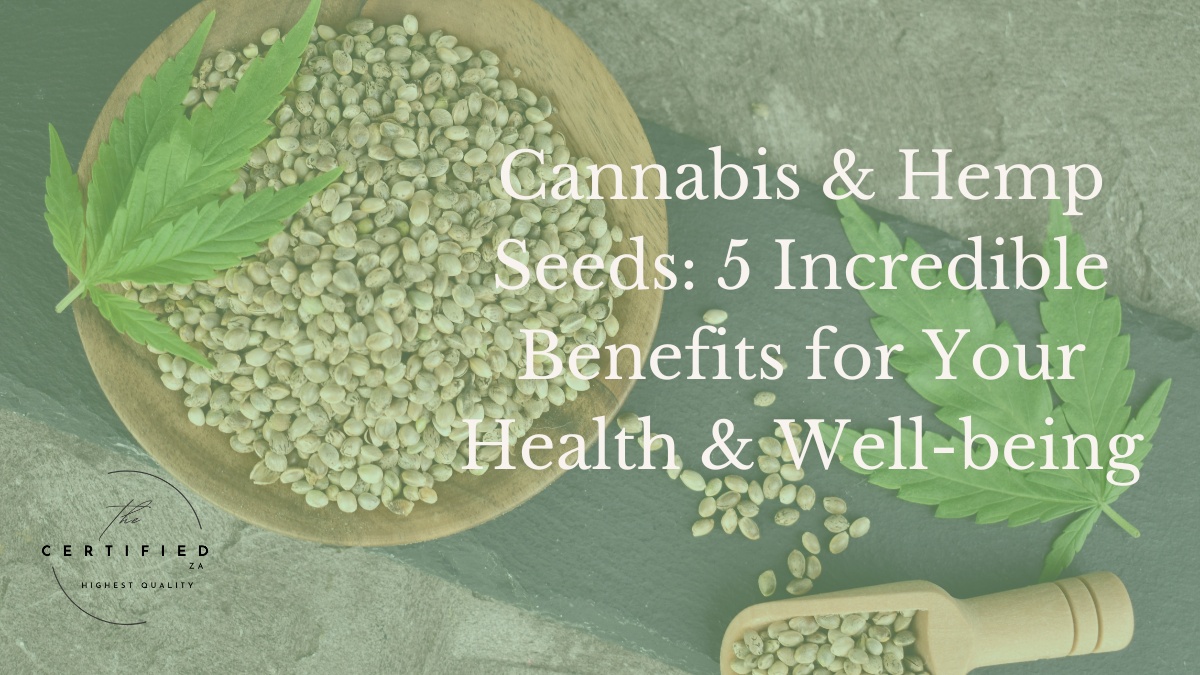
No audio available
From the lush fields of KwaZulu-Natal to the fertile plains of the Western Cape, South Africa is increasingly embracing the idea of cannabis and hemp as a totality. Historically, cannabis in its various forms has carried a heavy weight of stigma, often associated with recreational use. But today, a different narrative is taking root, one that celebrates cannabis and hemp, even embracing the plant in everyday life.
Much like the broader global trend, South Africa is seeing a growing interest in natural health solutions and diverse, plant-based food options. As our understanding of nutrition evolves, many South Africans are actively seeking out foods that not only nourish but also contribute to overall wellness. This is where cannabis & hemp seeds shine, offering a treasure trove of goodness without any psychoactive effects. Thanks to ongoing research and changing legislation, seeds are emerging as a valuable ingredient, poised to transform our everyday meals into functional foods with incredible health advantages.
1. The Powerhouse of Plant-Based Protein: Fuel for Your Body
In a nation that values hearty meals and strong bodies, the protein content of cannabis & hemp seeds are truly remarkable. These small but mighty seeds pack a serious punch, with whole seeds containing approximately 20-25% protein, and hulled seeds boasting an even more impressive 30-38.7% protein. This makes them a fantastic alternative to traditional protein sources, especially for those embracing plant-based diets or managing allergies.
What sets cannabis & hemp protein apart?
- Complete Amino Acid Profile: Unlike many other plant proteins that are missing some essential amino acids, cannabis & hemp protein contains all nine that our bodies cannot produce on their own. This makes it a “complete protein,” crucial for muscle repair, growth, and overall bodily function. Think of it as a one-stop shop for your protein needs!
- Highly Digestible: Research highlights that cannabis & hemp protein is easily digestible, with no natural protease inhibitors (compounds that can hinder protein breakdown) found in the seeds. This means your body can efficiently absorb and utilise this vital nutrient. Studies show digestibility rates of 84-86% for whole seeds and up to 92% for flour.
- Key Proteins: cannabis & Hemp’s protein magic comes from two main types:
- Edestin: Making up 60-80% of the total protein, edestin is a high-quality, easily absorbed protein, rich in sulfur-containing amino acids (like methionine and cysteine) that are often limited in other plant proteins.
- Albumin: Contributing about 25% of the total, albumin complements edestin, offering a well-rounded amino acid profile.
- Allergy-Friendly & Gluten-Free: For the many South Africans dealing with food sensitivities, cannabis & hemp seeds are a blessing. They are naturally gluten-free and have a very low allergenic profile, making them a safe and inclusive option for individuals with celiac disease or common allergies to soy or wheat.
Beyond basic nutrition, the peptides derived from cannabis & hemp protein also show promise with antioxidant, antihypertensive, antimicrobial, and even neuroprotective properties. These can contribute to managing cardiovascular risks, reducing inflammation, and supporting brain health – truly a protein that does more!
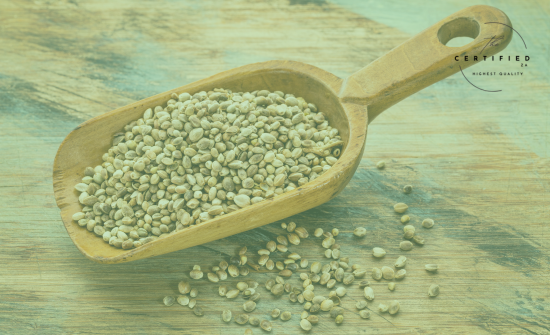
2. The Golden Ratio of Healthy Fats: A Friend to Your Heart
South Africa, like many parts of the world, faces significant challenges with non-communicable diseases, including heart disease. This makes the exceptional fat profile of cannabis & hemp seeds incredibly relevant. Cannabis & Hemp oil, making up 25-35% of the seed (and up to 52.3% in hulled seeds), is a liquid gold with a mild, nutty flavour – and its lovely green hue in cold-pressed form is all-natural, thanks to chlorophyll.
Here’s why cannabis & hemp fats are so special:
- Rich in Polyunsaturated Fatty Acids (PUFAs): Over 70% of the fatty acids in cannabis & hemp oil are PUFAs, which are essential for many bodily functions and must be obtained from our diet. These include:
- Linoleic Acid (LA – Omega-6): Essential for healthy skin, cell membranes, and overall growth. It constitutes 51.6-63.7% of hemp oil’s fatty acids.
- Alpha-Linolenic Acid (ALA – Omega-3): A crucial anti-inflammatory omega-3 fatty acid, important for heart health and brain function. Hemp oil contains a significant 10.5-26.2% ALA.
- Gamma-Linolenic Acid (GLA) and Stearidonic Acid: These are less common but highly beneficial fatty acids, contributing to hemp’s unique health benefits.
- The Optimal Omega-6 to Omega-3 Ratio: This is where cannabis & hemp truly shine! With a remarkably balanced ratio of 2.5:1 to 5.5:1 (often cited as an ideal 3:1), cannabis & hemp oil help maintain a healthy inflammatory balance in the body. Many modern diets are skewed towards too much omega-6, which can promote inflammation. Cannabis & Hemp provides these essential fats in perfect harmony, supporting heart health and reducing the risk of chronic inflammatory conditions.
- Natural Antioxidants: Seeds are rich in tocopherols (Vitamin E), with gamma-tocopherol being the most abundant form. These powerful antioxidants protect your cells from damage and help keep the delicate oils fresh. Think of them as the natural guardians of your well-being.
- Phytosterols for Cholesterol: These plant compounds, especially beta-sitosterol, are structurally similar to cholesterol and can help reduce its absorption in your gut, contributing to healthy cholesterol levels and cardiovascular health.
To get the most from these delicate fats, opt for cold-pressed hemp oil, which preserves its nutritional quality. It’s best used in uncooked applications like salad dressings (perfect for a fresh South African salad!), dips, or drizzled over steamed veggies or pap. Avoid high heat, as it can damage these beneficial compounds.
3. The Fibre Force: Nurturing Your Gut and Beyond
A healthy gut is the cornerstone of good health, and the seeds are an excellent ally in this regard. These seeds are a fantastic source of dietary fibre, contributing 20-30% of their total carbohydrate content. The majority of this is insoluble dietary fibre, which acts like a broom for your digestive system.
Here’s how cannabis & hemp fibre helps you thrive:
- Promotes Digestive Regularity: Insoluble fibre adds bulk to your stool, helping food move smoothly through your digestive tract. This aids in preventing constipation and maintaining a healthy, regular bowel rhythm – a common concern for many. The hull of the seed is especially rich in fibre, containing cellulose (46%), lignin (31%), and hemicellulose (22%).
- Manages Blood Sugar Levels: Fibre plays a crucial role in slowing down the absorption of sugars into the bloodstream. This helps prevent sudden spikes and crashes, making seeds particularly beneficial for individuals managing diabetes or looking to stabilise energy levels throughout the day.
- Supports Cholesterol Reduction: Dietary fibre can bind to cholesterol in the digestive system, facilitating its excretion and helping to lower overall blood cholesterol levels, further supporting heart health.
- Aids in Weight Management: Foods rich in fibre promote a feeling of fullness and satiety, which can help control appetite and support healthy weight management goals.
- Nourishes the Gut Microbiome: While mostly insoluble, some of the fibre in hemp seeds can be fermented by the beneficial bacteria in your gut. This process produces short-chain fatty acids (SCFAs), which are vital for gut health and have systemic benefits for the entire body.
Incorporating whole hemp seeds into your diet – perhaps sprinkled over your morning porridge, a fresh fruit salad, or even mixed into umphokoqo – is a simple yet effective way to boost your fibre intake and support overall digestive wellness.
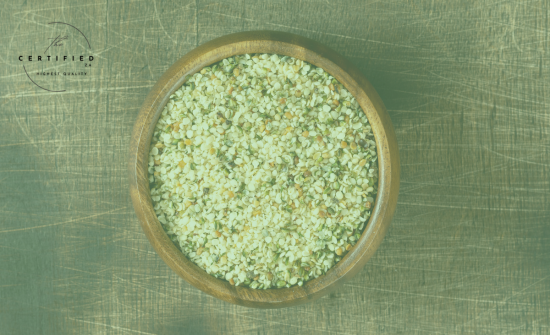
4. Micronutrient Marvels: Vitamins and Minerals for Vibrant Living
Beyond the macronutrients, hemp seeds are a micro-nutrient marvel, brimming with essential vitamins and minerals that are crucial for countless bodily processes and overall vitality.
Vitamins for Life:
Cannabis & hemp seeds provide a noteworthy contribution to your daily vitamin intake:
- Vitamin E (Tocopherols): A potent antioxidant, Vitamin E protects your cells from oxidative stress. A small serving of hemp seeds or hemp oil can easily meet your daily recommended allowance for this vital vitamin.
- Vitamins D and A: These fat-soluble vitamins are key for bone health, a robust immune system, and maintaining healthy vision.
- B-Vitamins (B1 & B9): Cannabis & Hemp seeds contain B1 (thiamine) and B9 (folate), which are essential for energy metabolism, nervous system function, and healthy cell division. These are vital for sustained energy and cognitive health, whether you’re tackling a busy workday or enjoying a hike up Table Mountain.
Minerals for Strength:
Hemp seeds are loaded with a diverse array of essential minerals:
- Phosphorus, Potassium, Magnesium: These macro-minerals are vital for strong bones, nerve function, muscle contractions, and maintaining electrolyte balance – especially important in our warm climate. Phosphorus is particularly abundant in hulled hemp seeds.
- Zinc & Copper: Essential for immune function, wound healing, and acting as antioxidants. Zinc, in particular, can provide a significant portion of your daily needs from a single serving.
- Manganese & Iron: Manganese is crucial for bone development and metabolism, while iron is fundamental for oxygen transport in the blood, combating fatigue and supporting overall energy levels.
- Calcium: Important for skeletal strength and numerous cellular processes.
While these minerals are generally quite stable, consuming hemp seeds in their minimally processed forms helps ensure you get the full spectrum of benefits. Although natural compounds like phytates can sometimes affect mineral absorption, traditional methods like fermentation (used in some food products) can help reduce these, enhancing the seeds’ overall bioavailability.
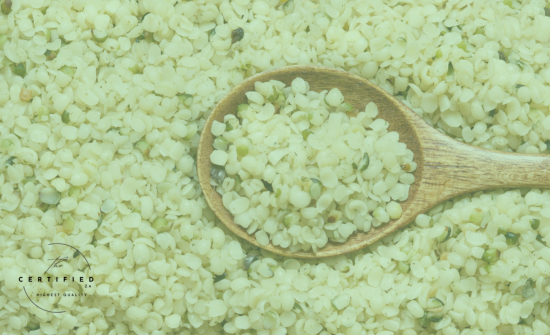
5. Bioactive Boosters: Unlocking Nature’s Therapeutic Potential
Cannabis & Hemp seeds are more than just a collection of basic nutrients; they are also a rich source of fascinating bioactive compounds – natural chemicals that offer therapeutic benefits beyond standard nutrition. These secondary metabolites work synergistically, contributing to overall well-being.
- Terpenes: The Scent of Health: These aromatic compounds give cannabis & hemp its distinct flavour and scent. Over 85 volatile terpenes have been identified in cannabis & hemp seed oil, including beta-myrcene, D-limonene, and beta-caryophyllene.
- Antioxidant & Anti-inflammatory: Terpenes actively protect cells from damage and help reduce inflammation, offering relief for conditions like osteoarthritis.
- Metabolic & Mood Support: Beta-caryophyllene, for example, has been linked to improving insulin sensitivity and regulating cholesterol. Other terpenes can contribute to balancing mood, reducing tension, and even supporting better sleep and anxiety management – a welcome boost in our fast-paced lives.
- Flavonoids: Nature’s Protectors: These powerful phenolic compounds are abundant in seeds, particularly in the hull. They are renowned for their wide-ranging health benefits:
- Antioxidant & Anti-inflammatory: Flavonoids are formidable protectors against cellular damage and chronic inflammation.
- Neuroprotective & Cardiovascular: They play a role in brain health, potentially offering protection against neurodegenerative diseases. Some flavonoids can also help regulate blood pressure by influencing nitric oxide levels, benefiting your heart.
- Carotenoids: Vision Protectors: Seeds also contain carotenoids like lutein and zeaxanthin, which are essential for eye health. These compounds accumulate in the macular region of the eye, protecting against light-induced damage and reducing the risk of age-related macular degeneration.
- Phytocannabinoids: Trace Amounts, Emerging Interest: It is crucial to understand that seeds contain only trace amounts of phytocannabinoids like Cannabidiol (CBD) and Tetrahydrocannabinol (THC). Industrial hemp is specifically bred to ensure THC levels are well below legal thresholds (e.g., 0.2-0.3%), meaning hemp seeds are non-psychoactive and entirely safe for consumption. While not a primary source of high-concentration cannabinoids, the minuscule amounts, particularly CBD, are being studied for their potential therapeutic benefits in managing pain and supporting neurological health. Any higher levels would typically be from external contamination of sticky resin during harvest, which is addressed through proper cleaning and processing. For food purposes, rest assured that hemp seeds are purely for their nutritional value, not for recreational effects.
These bioactive compounds highlight how hemp seeds offer a holistic approach to wellness, tapping into nature’s intricate chemistry to support various bodily systems.
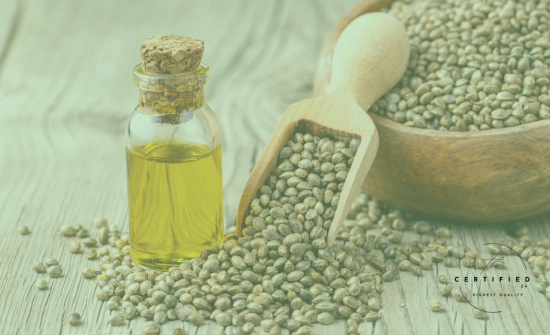
Bringing Hemp Seeds to the South African Table
The versatility of cannabis & hemp seeds means they can easily become a staple in the South African diet, enriching our local cuisine with their incredible benefits.
- Culinary Delights: Sprinkle shelled hemp seeds over your morning mieliepap, add them to smoothies with local fruits like mango and pawpaw, or stir them into yoghurts. They make a fantastic crunchy topping for salads, roasted vegetables, or even chakalaka.
- Baking & Beyond: Cannabis & Hemp flour can be a nutritious addition to your baking, whether you’re making gluten-free bread, muffins, rusks, or even vetkoek. Hemp protein powder can boost your post-workout shakes or energy bars.
- Hemp Milk: A creamy, plant-based milk alternative that’s perfect for those with lactose intolerance or simply seeking a healthier option. It can be used in teas, coffees, or poured over cereals.
- Hemp Oil: Drizzle cold-pressed hemp oil over a grilled braai salad or use it to make a vibrant vinaigrette.
As the market for natural and functional foods grows in South Africa, brands are increasingly exploring hemp-based products. Look for trusted local and international brands that offer shelled hemp seeds, hemp oil, hemp flour, and protein powders.
Embrace the Future of Food with Hemp
Cannabis & Hemp seeds are truly a gift from nature, perfectly aligned with our modern quest for holistic health and sustainable living. Their remarkable blend of digestible protein, heart-healthy fats, vital fibre, essential vitamins and minerals, and powerful bioactive compounds makes them an unparalleled superfood.
In South Africa, where we cherish both our traditions and our forward-thinking spirit, seeds offer an exciting opportunity. They represent a bridge between ancient wisdom and modern nutritional science, promising a path to enhanced well-being for individuals and a more sustainable food system for our nation.









